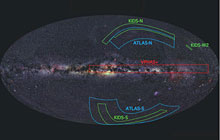VLT Survey Telescope
The VLT Survey Telescope (VST) is located at ESO’s Paranal Observatory, and it surveys the sky in visible light with its 2.6-m primary mirror. It is equipped with an enormous 268-megapixel camera called OmegaCAM that is the successor of the very successful Wide Field Imager (WFI) currently installed at the 2.2-m MPG/ESO Telescope on La Silla.
Like the VLT, the VST covers a wide-range of wavelengths from ultraviolet through optical to the near-infrared (0.3 to 1.0 microns). But whereas the largest telescopes, such as the VLT, can only study a small part of the sky at any one time, the VST is designed to photograph large areas quickly and deeply.
With a total field view of 1°x 1°, twice as broad as the full Moon, the VST supports the VLT with wide-angle imaging by detecting and pre-characterising sources, which the VLT Unit Telescopes can then observe further.
The VST comprises two mirrors, a primary mirror (M1) with a diameter of 2.61 m and a smaller secondary mirror (M2) with a diameter of 93.8 cm. The telescope is also equipped with a single dedicated focal plane instrument: OmegaCAM. This huge (16k x 16k pixel) CCD camera was built by an international consortium of five institutions: the Netherlands Research School for Astronomy (NOVA), the Kapteyn Astronomical Institute, Universitäts-Sternwarte München, the Astronomical Observatory of Padova and ESO.
Science with the VST
 The VST is dedicated to survey programmes. With its state-of-the-art camera, the quality of its optics, and the exceptional seeing conditions of Paranal, the VST is making important discoveries in a variety of areas of astrophysics and cosmology. In planetary science, the survey telescope aims to discover and study remote Solar System bodies such as trans-Neptunian objects, as well as search for extrasolar planet transits. The Galactic plane is also being extensively studied and is providing astronomers with data crucial for understanding the structure and evolution of our Galaxy. Further afield, the VST is exploring nearby galaxies, extragalactic and intra-cluster planetary nebulae, and performing surveys of faint object and micro-lensing events. In the field of cosmology, the VST is targeting medium-redshift supernovae to help pin down the cosmic distance scale and understand the expansion of the Universe. The VST is also looking for cosmic structures at medium-high redshift, active galactic nuclei and quasars to further our understanding of galaxy formation and the Universe’s early history.
The VST is dedicated to survey programmes. With its state-of-the-art camera, the quality of its optics, and the exceptional seeing conditions of Paranal, the VST is making important discoveries in a variety of areas of astrophysics and cosmology. In planetary science, the survey telescope aims to discover and study remote Solar System bodies such as trans-Neptunian objects, as well as search for extrasolar planet transits. The Galactic plane is also being extensively studied and is providing astronomers with data crucial for understanding the structure and evolution of our Galaxy. Further afield, the VST is exploring nearby galaxies, extragalactic and intra-cluster planetary nebulae, and performing surveys of faint object and micro-lensing events. In the field of cosmology, the VST is targeting medium-redshift supernovae to help pin down the cosmic distance scale and understand the expansion of the Universe. The VST is also looking for cosmic structures at medium-high redshift, active galactic nuclei and quasars to further our understanding of galaxy formation and the Universe’s early history.
The VST project was a joint venture between the European Southern Observatory and the Capodimonte Astronomical Observatory (OAC), part of the Italian National Institute for Astrophysics (INAF). As of late 2022, this is a sole project of INAF, hosted by ESO at Paranal.
The telescope became operational in 2011.
Science goals
Devoted to surveys. Milky way, extragalactic planetary nebulae, cosmology.
More about the VST
- The VST mirror
- The VST camera
- The VST surveys
- For Scientists: Details for observers using VST are available at: OmegaCAM at the VST page
Latest image
Follow the VST on this live image updated every hour during daytime. Click on it to enlarge.
VST
|
|
Did you know?
The Paranal observatory site is so remote that everything needed must be brought in specially. The 60 000 litres of water that are used per day are delivered by truck from Antofagasta. |

